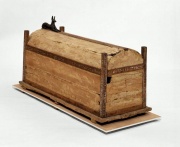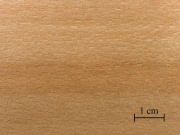Difference between revisions of "Sycamore"
(username removed) |
JMcGlinchey (talk | contribs) |
||
| Line 24: | Line 24: | ||
| 22-43 ppcf | | 22-43 ppcf | ||
|} | |} | ||
| + | |||
| + | Paper fiber type: hardwood, diffuse porous. Using transmitted light microscopy, pulp is identified by variable-sized vessels with alternate pitting. Perforations are scalariform, typically on both ends. Appearance with [[Graff "C" stain]]: dark blue, but varies with bleaching. Common pulping method: [[kraft process|kraft]]. | ||
== Additional Images == | == Additional Images == | ||
Revision as of 14:00, 16 July 2015
Description
1) Any of several deciduous trees of the genus Platanus, especially Platanus occidentalis (buttonwood) found in eastern North America. In Europe, they are commonly called plane trees. This tree has a pale, reddish-brown, close-grain wood that is tough and takes a fine polish. The wood is used for tool handles, rollers, flooring, furniture, crates, butcher blocks, musical instruments, and veneer. See London plane.
2) A type of maple tree, Acer pseudoplatanus, native to Europe and Asia. Also called harewood, the tree has a light colored wood with a straight grain and even texture. It is used for inlays, veneer, and millwork.
3) A fig tree, Ficus sycamorus, native to Africa and southwest Asia.
Synonyms and Related Terms
1. Platanus occidentalis; American sycamore; American plane tree; harewood; buttonwood; buttonball; sycomore (Fr.)
Other Properties
1. Large tree growing to 40 m with spreading branches Bark=thin gray-brown exfoliating to form light patches. Fruit=ball containing tufted aches.
| Density | 22-43 ppcf |
|---|
Paper fiber type: hardwood, diffuse porous. Using transmitted light microscopy, pulp is identified by variable-sized vessels with alternate pitting. Perforations are scalariform, typically on both ends. Appearance with Graff "C" stain: dark blue, but varies with bleaching. Common pulping method: kraft.
Additional Images
Authority
- R. J. Gettens, G.L. Stout, Painting Materials, A Short Encyclopaedia, Dover Publications, New York, 1966
- G.S.Brady, Materials Handbook, McGraw-Hill Book Co., New York, 1971 Comment: p. 788
- Ralph Mayer, A Dictionary of Art Terms and Techniques, Harper and Row Publishers, New York, 1969 (also 1945 printing)
- F. H. Titmuss, Commercial Timbers of the World, The Technical Press Ltd., London, 1965 Comment: 22-43 ppcf
- Encyclopedia Britannica, http://www.britannica.com Comment: sycamore" Encyclopædia Britannica [Accessed November 7, 2001].
- Edward Reich, Carlton J. Siegler, Consumer Goods: How to Know and Use Them, American Book Company, New York City, 1937
- Website address 1 Comment: Virginia Tech Dendrology website at www.fw.vt.edu/dendro/dendrology/main.htm (Accessed Dec. 9, 2005)
- Wikipedia, the free encyclopedia, at http://www.wikipedia.com Comment: http://en.wikipedia.org/wiki/American_Sycamore (Accessed Dec. 9, 2005)
- CRC Handbook of Chemistry and Physics, Robert Weast (ed.), CRC Press, Boca Raton, Florida, v. 61, 1980 Comment: density=24-37 ppcf (0.40-0.60 g/cm3)
- George Savage, Art and Antique Restorer's Handbook, Rockliff Publishing Corp, London, 1954




